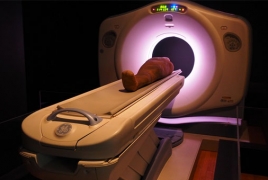Museums use CT scans to demystify mummies March 21, 2017 - 14:09 AMT PanARMENIAN.Net - Most of us have a rather cinematic view of mummies: a bandaged body rising out of a sarcophagus, stumbling toward whoever just disturbed their slumber. Of course, this could never happen and not just for supernatural reasons. Mummies are wrapped up pretty tight and are just too old and fragile to do anything. In fact, they're often too delicate for scientists to even study them, meaning many human remains have sat in storage for more than a century. However, an exhibit making its way to New York's American History of Natural History on March 20 not only takes them out of the warehouse, but also tells us more about the people wrapped inside, thanks to some help from modern technology, Engadget said. "Mummies" was developed by Chicago's Field Museum, which lays claim to the largest collection of Egyptian and Peruvian specimens in the US. But many of these haven't been seen by the public since the 1893 Chicago World's Fair. Back then, the only way to take a closer look was to physically unwrap the body, risking damage to the funereal objects and preserved remains. When X-rays arrived on the scene, they presented a boon to researchers, finally letting them peek inside. The first mummy was photographed this way in 1898, and the Field Museum's entire collection was examined and written about in 1931. But standard X-rays are lacking in nuance: They're limited to 2D representation, capture a lot of irrelevant data, and can't distinguish between objects of different densities. Computed tomography scanning addresses all these problems. The first time a mummy was examined via CT was way back in 1977, just four years after the tech appeared in hospitals. But it's only in the past decade that the Field Museum did a deep dive into its collection. This was made possible with portable CT scanners that could be brought to its facility, rather than taking the risk of transporting specimens to a hospital or lab. The researchers at the Field learned a lot. One body, the "Gilded Lady," belonged to a middle-aged woman who lived during the Roman era. They found she had an overbite and tight curly hair. Another mummy whose coffin identified him as "Minirdis" turned out to not be Minirdis at all; the body was 200 years younger than the coffin, indicating that the box was recycled. The CT scans provided enough info that the scientists were able to print 3D copies of the skulls, passing them off to an artist to do full facial reconstructions that are also on display. 3D printing factors somewhat heavily in the exhibition, allowing museums like the AMNH to showcase replicas of various artifacts. This allows visitors to examine small details they might often miss when the object is trapped behind glass, as well as getting a better sense of the object's size and weight. Another way visitors are given an intimate look at the mummies is through a series of touchscreens that let people "virtually unwrap" them, delving down through each individual layer: skin, bones, organs and small artifacts buried with the body. This is particularly revealing when it comes to the Peruvian remains, which were often buried in "bundles" instead of laid out flat. The bodies were placed in a sitting position and then wrapped up, with objects of significance tucked into each layer. How the body was positioned and where each item was located holds a lot of useful information about that person and their culture, which would have been remained unknown without the CT scan, and completely lost if scientists ever risked unwrapping the human specimens. Of course, CT scans can't reveal everything. While DNA testing and isotopic sampling can provide troves of information, they still involve some physical intrusion on the remains. James Phillips, a curator at the Field Museum told me that his most-wanted technological advancement would be some way to obtain DNA without having to drill into the body. For the scientists at both the Field and the AMNH, this is the ultimate goal: To treat human remains respectfully and non-invasively, gaining as much knowledge as possible from them while ensuring they'll still be around for a few more millennia, Engadget said. Photo: Engadget Yerevan will host the 2024 edition of the World Congress On Information Technology (WCIT). Rustam Badasyan said due to the lack of such regulation, the state budget is deprived of VAT revenues. Krisp’s smart noise suppression tech silences ambient sounds and isolates your voice for calls. Gurgen Khachatryan claimed that the "illegalities have been taking place in 2020." Partner news |